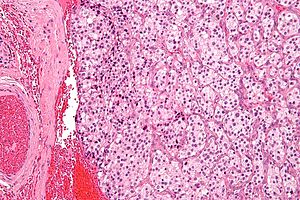Paraganglioma
| Paraganglioma | |
|---|---|
 |
|
| Micrograph of a carotid body tumor (a type of paraganglioma). | |
| Classification and external resources | |
| Specialty | oncology |
| ICD-10 | C75.4, C75.5, D35.5, D35.6, D44.6, D44.7 |
| ICD-9-CM | 194.5, 194.6, 227.5, 227.6, 237.3 |
| ICD-O | M8680/0 - M8693/9 |
| DiseasesDB | 33480 |
| eMedicine | med/2994 |
| MeSH | D010235 |
A paraganglioma is a rare neuroendocrine neoplasm that may develop at various body sites (including the head, neck, thorax and abdomen). About 97% are benign and cured by surgical removal; the remaining 3% are malignant because they are able to produce distant metastases. "Paraganglioma" is now the most-widely accepted term for these lesions, that have been also described as: glomus tumor, chemodectoma, perithelioma, fibroangioma, and sympathetic nevi.
Paragangliomas originate from paraganglia in chromaffin-negative glomus cells derived from the embryonic neural crest, functioning as part of the sympathetic nervous system (a branch of the autonomic nervous system). These cells normally act as special chemoreceptors located along blood vessels, particularly in the carotid bodies (at the bifurcation of the common carotid artery in the neck) and in aortic bodies (near the aortic arch).
Accordingly, paragangliomas are categorised as originating from a neural cell line in the World Health Organization classification of neuroendocrine tumors. In the categorization proposed by Wick, paragangliomas belong to group II. Given the fact that they originate from cells of the orthosympathetic system, paragangliomas are closely related to pheochromocytomas, which however are chromaffin-positive.
Most paragangliomas are either asymptomatic or present as a painless mass. While all contain neurosecretory granules, only in 1–3% of cases is secretion of hormones such as catecholamines abundant enough to be clinically significant; in that case manifestations often resemble those of pheochromocytomas (intra-medullary paraganglioma).
...
Wikipedia
